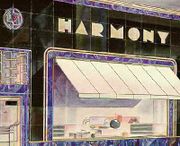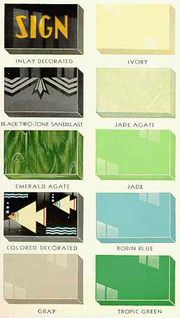Difference between revisions of "Structural glass"
m (Text replace - "== Authority ==" to "== Sources Checked for Data in Record ==") |
|||
| (5 intermediate revisions by the same user not shown) | |||
| Line 1: | Line 1: | ||
| + | [[File:Vitiolite poster.jpg|thumb|Libbey-Owens poster]] | ||
| + | [[File:Vitriolit colors.jpg|thumb|Colors of Vitrolite]] | ||
== Description == | == Description == | ||
| − | A general term for a variety of architectural glasses but usually refers to colored opaque glass slabs (Dyson, 1995). About 1900, opaque glass slabs (Sani-Onyx) were first developed as a sanitary alternative to white marble slab table surfaces. Opaque structural glass was composed of silica, feldspar, fluorspar (for opacity), kaolin, cryolite, manganese and inorganic colorants. The sheets were cast then rolled to form a smooth even surface. They were cooled slowly, then fire-polished to produce a smooth satiny finish. Some glass pieces were polished to achieve a high gloss. Opaque glass was available in many colors, but most common were white and black. Structural glass was popularly used in the 1920 to 1940s for exterior cladding on storefronts, service stations, movie theaters and automobile dealerships. It was also used for interior clean surface areas such as hospital operating rooms, hotel lobbies, restaurants, kitchens, and bathrooms. | + | A general term for a variety of architectural glasses but usually refers to colored opaque glass slabs (Dyson, 1995). About 1900, opaque glass slabs (Sani-Onyx) were first developed as a sanitary alternative to white marble slab table surfaces. Opaque structural glass was composed of [[silica]], [[borax]], [[feldspar]], [[fluorspar]] (for opacity), [[kaolin]], [[cryolite]], [[manganese]] and inorganic colorants. The sheets were cast then rolled to form a smooth even surface. They were cooled slowly, then fire-polished to produce a smooth satiny finish. Some glass pieces were polished to achieve a high gloss. Opaque glass was available in many colors, but most common were white and black. Structural glass was popularly used in the 1920 to 1940s for exterior cladding on storefronts, service stations, movie theaters and automobile dealerships. It was also used for interior clean surface areas such as hospital operating rooms, hotel lobbies, restaurants, kitchens, and bathrooms. |
== Synonyms and Related Terms == | == Synonyms and Related Terms == | ||
| Line 7: | Line 9: | ||
recreated rock slab; sanitary glass; vidro para construção (Port.); Argentine; Carrara® [PPG]; Glastone; Marbrunite; Nuralite; Opalite; Sani-Onyx [Marietta Manufacturing]; Vitrolite [Libbey-Owens-Ford] | recreated rock slab; sanitary glass; vidro para construção (Port.); Argentine; Carrara® [PPG]; Glastone; Marbrunite; Nuralite; Opalite; Sani-Onyx [Marietta Manufacturing]; Vitrolite [Libbey-Owens-Ford] | ||
| − | == | + | == Risks == |
| − | Easily broken by impact | + | * Easily broken by impact |
| − | == | + | == Resources and Citations == |
| − | + | * C. Dyson, "Structural Glass", in ''Twentieth-Century Building Materials'', T. Jester (ed.), McGraw-Hill: New York, 1995. | |
| + | * "The Preservation of Historic Pigmented Structural Glass (Vitrolite and Carrara Glass)", Preservation Brief 12, National Park Service. [http://www2.cr.nps.gov/tps/briefs/brief12.htm Link] | ||
| − | + | * The Old House Web: 'Structural Pigmented Glass' [http://www.oldhouseweb.com/how-to-advice/structural-pigmented-glass-part-1.shtml link] | |
* ''Dictionary of Building Preservation'', Ward Bucher, ed., John Wiley & Sons, Inc., New York City, 1996 | * ''Dictionary of Building Preservation'', Ward Bucher, ed., John Wiley & Sons, Inc., New York City, 1996 | ||
| Line 21: | Line 24: | ||
* Anne Grimmer, Glossary of Building Stone Terms, ''A Glossary of Historic Masonry Deterioration Problems and Preservation Treatments'', National Park Service, Washington DC, 1984 | * Anne Grimmer, Glossary of Building Stone Terms, ''A Glossary of Historic Masonry Deterioration Problems and Preservation Treatments'', National Park Service, Washington DC, 1984 | ||
| − | + | * Wikipedia: https://en.wikipedia.org/wiki/Pigmented_structural_glass (accessed August 2020). | |
[[Category:Materials database]] | [[Category:Materials database]] | ||
Latest revision as of 11:42, 6 June 2022
Description
A general term for a variety of architectural glasses but usually refers to colored opaque glass slabs (Dyson, 1995). About 1900, opaque glass slabs (Sani-Onyx) were first developed as a sanitary alternative to white marble slab table surfaces. Opaque structural glass was composed of Silica, Borax, Feldspar, Fluorspar (for opacity), Kaolin, Cryolite, Manganese and inorganic colorants. The sheets were cast then rolled to form a smooth even surface. They were cooled slowly, then fire-polished to produce a smooth satiny finish. Some glass pieces were polished to achieve a high gloss. Opaque glass was available in many colors, but most common were white and black. Structural glass was popularly used in the 1920 to 1940s for exterior cladding on storefronts, service stations, movie theaters and automobile dealerships. It was also used for interior clean surface areas such as hospital operating rooms, hotel lobbies, restaurants, kitchens, and bathrooms.
Synonyms and Related Terms
recreated rock slab; sanitary glass; vidro para construção (Port.); Argentine; Carrara® [PPG]; Glastone; Marbrunite; Nuralite; Opalite; Sani-Onyx [Marietta Manufacturing]; Vitrolite [Libbey-Owens-Ford]
Risks
- Easily broken by impact
Resources and Citations
- C. Dyson, "Structural Glass", in Twentieth-Century Building Materials, T. Jester (ed.), McGraw-Hill: New York, 1995.
- "The Preservation of Historic Pigmented Structural Glass (Vitrolite and Carrara Glass)", Preservation Brief 12, National Park Service. Link
- The Old House Web: 'Structural Pigmented Glass' link
- Dictionary of Building Preservation, Ward Bucher, ed., John Wiley & Sons, Inc., New York City, 1996
- Anne Grimmer, Glossary of Building Stone Terms, A Glossary of Historic Masonry Deterioration Problems and Preservation Treatments, National Park Service, Washington DC, 1984
- Wikipedia: https://en.wikipedia.org/wiki/Pigmented_structural_glass (accessed August 2020).

